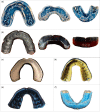Dental injuries in Swiss soccer supporters: A comparative study of regular fans, ultras, and hooligans for public health strategies
- PMID: 37735812
- PMCID: PMC10728521
- DOI: 10.1002/cre2.783
Dental injuries in Swiss soccer supporters: A comparative study of regular fans, ultras, and hooligans for public health strategies
Abstract
Objectives: Violence among soccer supporters continues to pose a significant public health concern in many parts of the world. In Switzerland, hooliganism is largely uninvestigated. This study aimed to examine incidents of violence and associated dental injuries among different groups of soccer supporters, as well as assess the impact of intoxicants on their behavior, using survey data from regular fans, ultras, and hooligans in the Swiss Football League.
Material and methods: A cross-sectional survey using a standardized questionnaire was conducted among distinct factions of soccer supporters in the Swiss Football League in 2022. A total of 165 participants self-identified as belonging to one of three subgroups: "regular fan," "ultra," or "hooligan." Data were gathered on physical altercations, dental injuries, possession of mouthguards, intoxicant use, and medical assistance. Descriptive statistics, logistic regression models, and significance tests were used for data analysis (α = .05).
Results: Hooligans had a higher frequency of dental injuries resulting from fights than ultras and regular fans. Hooligans with 11-20 fights per soccer season had a 9.6 times higher probability of dental trauma than those with 0-5 fights (p = .048). Possession of a mouthguard was associated with a lower risk of dental injuries for hooligans but an increased risk for ultras. Additionally, hooligans were found to differ significantly from other groups in their consumption of amphetamines and cocaine (p < .001).
Conclusions: The study found a strong link between physical altercations and dental injuries among soccer supporters. To promote better prevention, there is a necessity for enhanced educational initiatives facilitated by dentists to amplify the dissemination of mouthguards. Furthermore, it is crucial to raise awareness regarding their proper fitting to minimize the occurrence of combat-related dental injuries. Health authorities and other stakeholders should take a comprehensive approach to addressing some of the root causes of violent behavior, which include alcohol abuse and illicit substance consumption.
Keywords: accident prevention; dental trauma; fan violence; hooligans; mouthguard; substance intoxication.
© 2023 The Authors. Clinical and Experimental Dental Research published by John Wiley & Sons Ltd.
Conflict of interest statement
The authors declare no conflict of interest.
Figures


Similar articles
-
Dental and jaw injuries sustained by hooligans.Dent Traumatol. 2015 Dec;31(6):477-81. doi: 10.1111/edt.12205. Epub 2015 Jul 15. Dent Traumatol. 2015. PMID: 26176293
-
Knowledge of traumatic dental injuries and mouthguard behavior among Croatian soccer players.Dent Traumatol. 2023 Dec;39(6):555-564. doi: 10.1111/edt.12862. Epub 2023 Jun 21. Dent Traumatol. 2023. PMID: 37341423
-
Survey on the occurrence of dental trauma and preventive strategies among Brazilian professional soccer players.J Appl Oral Sci. 2010 Dec;18(6):572-6. doi: 10.1590/s1678-77572010000600007. J Appl Oral Sci. 2010. PMID: 21308287 Free PMC article.
-
Dental and general injuries among ski and snowboard instructors in Switzerland, Germany, and Austria-A questionnaire-based study.Clin Exp Dent Res. 2022 Feb;8(1):37-44. doi: 10.1002/cre2.518. Epub 2021 Dec 14. Clin Exp Dent Res. 2022. PMID: 34907662 Free PMC article. Review.
-
'Bataille's boys': postmodernity, Fascists and football fans.Br J Sociol. 2000 Sep;51(3):443-60. Br J Sociol. 2000. PMID: 11038132 Review.
Cited by
-
Multimodal treatment of attention-deficit/hyperactivity disorder and comorbid symptoms in an ultra football fan: A case report from Switzerland.SAGE Open Med Case Rep. 2024 Sep 8;12:2050313X241280766. doi: 10.1177/2050313X241280766. eCollection 2024. SAGE Open Med Case Rep. 2024. PMID: 39253591 Free PMC article.
References
-
- Brandão, T. , Murad, M. , Belmont, R. , & Santos, R. F. (2021). Alcohol and violence: Brazilian organized football fans. Movimento, 26, e26001.
-
- Brechbühl, A. , Schumacher Dimech, A. , Schmid, O. N. , & Seiler, R. (2017). Escalation vs. non‐escalation of fan violence in football? Narratives from ultra fans, police officers and security employees. Sport in Society, 20, 861–879.
-
- Bundesamt für Polizei (fedpol) . (2023). Gesamtschweizerisches Lagebild Sport (GSLS‐Reporting). fedpol.admin.ch. https://www.fedpol.admin.ch/fedpol/de/home/sicherheit/hooliganismus/zahl...
-
- Chermack, S. T. , & Giancola, P. R. (1997). The relation between alcohol and aggression: An integrated biopsychosocial conceptualization. Clinical Psychology Review, 17, 621–649. - PubMed
MeSH terms
Grants and funding
LinkOut - more resources
Full Text Sources

